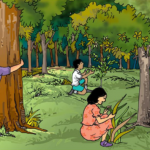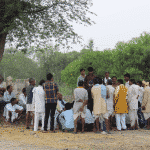NCERT short notes
Contents
class-7-ch-1-science
Nutrition
- The mode of taking food by an organism and its utilisation by the body.
- When organisms make food themselves from simple substances: Autotrophic nutrition. Therefore, plants are called autotrophs.
- Animals and most other organisms take in ready made food prepared by the plants and are called heterotrophs.
How do plants prepare food?
- Water and minerals present in the soil are absorbed by the roots and transported to the leaves where food is synthesised.
- Carbon dioxide from air is taken in through the tiny pores present on the surface of the leaves. These pores are called stomata and are surrounded by ‘guard cells’.
- The leaves have a green pigment called chlorophyll. It helps leaves to capture the energy of the sunlight. This energy is used to prepare food from carbon dioxide and water. Since the synthesis of food occurs in the presence of sunlight, it is called photosynthesis (Photo: light; synthesis : to combine).
- So we find that chlorophyll, sunlight, carbon dioxide and water are necessary to carry out the process of photosynthesis.
- The solar energy is captured by the leaves and stored in the plant in the form of food. Thus, sun is the ultimate source of energy for all living organisms.
- Oxygen is produced during photosynthesis.
- This process can also occur in green stems and green branches of the plant.
- Desert plants have spine-like leaves to reduce loss of water by transpiration. So, the green stems carry out photosynthesis in these plants.
- During photosynthesis, chlorophyll containing cells of leaves, in the presence of sunlight, use carbon dioxide and water to synthesise carbohydrates.
Getting to Know Plants-Class 6 Chapter 7
The process of photosynthesis can be represented as an equation:

- The carbohydrates ultimately get converted into starch. The presence of starch in leaves indicates the occurrence of photosynthesis. The starch is also a carbohydrate.
- Algae can also prepare their own food by photosynthesis.
Synthesis of plant food other than carbohydrates
- Carbohydrates are made of carbon, hydrogen and oxygen. These are used to synthesise other components of food such as proteins and fats. But proteins contain nitrogen. From where do the plants obtain nitrogen?
- Though nitrogen is present in abundance in gaseous form in the air, plants cannot absorb it in this form.
- Soil has certain bacteria called Rhizobium that converts gaseous nitrogen into a usable form and release it into the soil. These soluble forms are absorbed by the plants along with water.
Parasitic Nutrition
- Some plants which do not have chlorophyll cannot synthesise their food. Like humans and animals such plants depend on the food produced by other plants i.e., they use the heterotrophic mode of nutrition.
- Cuscuta (Amarbel) does not have chlorophyll. It takes readymade food from the plant on which it is climbing. The plant on which it climbs is called a host. Since it deprives the host of valuable nutrients, it is called a parasite.
- There are a few plants which can trap insects and digest them. Such insect-eating plants are called insectivorous plants.
Science Class 6 Ch 15: Short Notes- Air Around Us
Saprotrophic Nutrition
- Organisms like fungi have a different mode of nutrition. They secrete digestive juices on the dead and decaying matter and convert it into a solution. Then they absorb the nutrients from it.
- This mode of nutrition in which organisms take in nutrients in solution form from dead and decaying matter is called saprotrophic nutrition.
- Plants which use saprotrophic mode of nutrition are called saprotrophs.
- Fungi also grow on pickles, leather, clothes and other articles that are left in hot and humid weather for long time.
- The fungal spores are generally present in the air. When they land on wet and warm things they germinate and grow.
Symbiotic Relationship
- Some organisms live together and share shelter and nutrients. This is called symbiotic relationship.
- For example, certain fungi live in the roots of trees. The tree provides nutrients to the fungus and, in return, receives help from it to take up water and nutrients from the soil.
- In organisms called lichens, a chlorophyll-containing partner, which is an alga, and a fungus live together. The fungus provides shelter, water and minerals to the alga and, in return, the alga provides food which it prepares by photosynthesis.
- Rhizobium cannot make its own food. So it lives in the roots of gram, peas, moong, beans and other legumes and provides them with nitrogen. Most of the pulses (dals) are obtained from leguminous plants. In return, the plants provide food and shelter to the bacteria. This association is of great significance for the farmers as they do not need to add nitrogen fertiliser to the soil in which leguminous plants are grown.
How Nutrients Are Replenished In The Soil
- Plants absorb mineral nutrients from the soil. So, their amounts in the soil keep on declining.
- Fertilisers and manures contain plant nutrients such as nitrogen, potassium, phosphorous, etc. These nutrients need to be added from time to time to enrich the soil.
- We can grow plants and keep them healthy if we can fulfil the nutrient requirement of plants.
Living Organisms & their Surroundings- Class 6 Chapter 9
Cell
- The bodies of living organisms are made of tiny units called cells.
- The cell is enclosed by a thin outer boundary called the cell membrane.
- Most cells have a distinct, centrally located spherical structure called the nucleus.
- The nucleus is surrounded by a jelly-like substance called cytoplasm.











